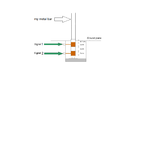ghasem_008
Full Member level 4

Hi.
I want to plot antenna efficiency using numerical methods(such as finite difference)
what is meaning of "frequency" in antenna efficiency calculation?
I know that:
η(f) = radiated power(f) / input power(f)
and I know that " f " in radiated power calculation is "far field frequency" , such that in radiated power formula f is according with k0 = 2*pi*f/3e8.
but I don't know meaning of "f" in input power.what is it's mean?
I know that input power is :
Pin = 0.5*Real[V(w)*I(w)] , where V and I are voltage and current inputs to antenna.
Now,I want to plot antenna efficiency relation versus frequencies (for example VHF band:f=(30-300) MHz).
I have got antenna radiated power values versus frequency.BUT,I don't know that what is meaning of frequency in antenna input power.
I think that input power doesn't any relation to far field frequency.SO,how calculate and plot antenna efficiency formula?
thanks
ghasem
I want to plot antenna efficiency using numerical methods(such as finite difference)
what is meaning of "frequency" in antenna efficiency calculation?
I know that:
η(f) = radiated power(f) / input power(f)
and I know that " f " in radiated power calculation is "far field frequency" , such that in radiated power formula f is according with k0 = 2*pi*f/3e8.
but I don't know meaning of "f" in input power.what is it's mean?
I know that input power is :
Pin = 0.5*Real[V(w)*I(w)] , where V and I are voltage and current inputs to antenna.
Now,I want to plot antenna efficiency relation versus frequencies (for example VHF band:f=(30-300) MHz).
I have got antenna radiated power values versus frequency.BUT,I don't know that what is meaning of frequency in antenna input power.
I think that input power doesn't any relation to far field frequency.SO,how calculate and plot antenna efficiency formula?
thanks
ghasem



